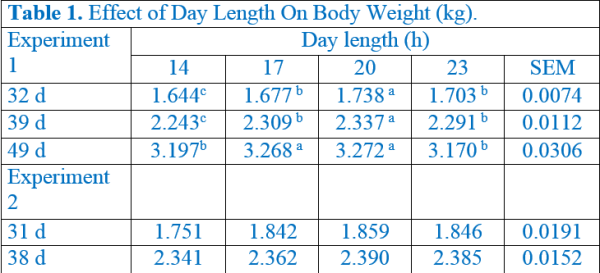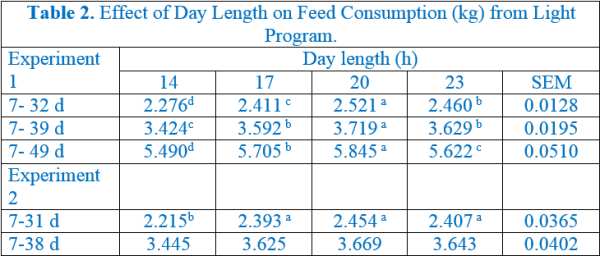Day Length Affecting Performance Traits of Commercial Poultry
Feed-related problems, diseases and bad management practices in intensive layer houses can result in a decreased number of eggs and also eggs which are abnormal in shape and color.
Decreased egg production results in a smaller profit to farmers and less money in their pockets. Therefore, it is important to know how to prevent these factors affecting egg production.
Vision is likely the most important sensory tool available to domestic poultry. Poultry birds (broiler and layers) rely on vision more than any other sense. Light is the primary zeitgeber in the control of biological rhythms and to be able to do this, it must be perceived by the brain. Light is the primary tool used by the body to entrain circadian rhythms. Constant or near-constant lighting programs had been a traditional choice of farmers, primarily with the thought that it could provide constant visual access to feeders and water troughs, which ultimately resulted in maximize feed consumption and growth. Although various lighting programs involving more darkness exposure have been studied and recommended, nearly continuous day length is still common in commercial broiler production. The 1 hour (h) of darkness in the 23 light (L):1 dark (D) schedule has not been provided as a period for rest or sleep.
 |
| Effect of light on broiler performance |
Light is an important management technique in broiler production and is composed of three aspects, light wavelength, light intensity and photoperiod length & distribution. In environmentally controlled housing systems, birds are exposed to artificial light. So source, intensity, spectra and regimen of light had major impact in modern broiler management. Long dark periods enhanced the growth more than continuous light but extended darkness without light provision resulted in impaired growth. Gorden (1994) concluded that maximum benefit could be obtained by rearing broilers under lighting regimen of 16 h per day.
A lack of darkness in many species had negative consequences on biological or physiological reactions in the body. The exposure of young mice to continuous light altered body circadian rhythms, and had a lasting effect on these rhythms rest of their life. Also true in birds, this could have important implications in newly hatched chicks, which generally given long day length lighting programs after placement during brooding.
The mechanism of action in the bird is different than other species, as light perception can occur via the retina as in other species, and at appropriate light intensities, can penetrate through the skull to directly affect photoreceptors in the pineal gland and the hypothalamus. The pineal gland also serves as a circadian clock in the body (Minneman and Wurtman, 1976) while the hypothalamus serves a vital role in initiating the sequence of events required for reproduction and growth. This starts with the release of growth hormone and gonadotropins, which in turn affects luteinizing hormone and follicle stimulating hormone produced in the pituitary gland (Lewis and Morris, 2006). When light comes in contact with photoreceptor in the retina and pineal gland, photons are transformed to neurological activity which passes this signal to the hypothalamus.
The pineal gland synthesizes and secretes melatonin (Figure 1), a structurally simple hormone that communicates information about environmental lighting to various parts of the body. Melatonin is itself a derivative of another biogenic amine, serotonin (Minneman and Wurtman, 1976). Melatonin has the ability to entrain biological rhythms and has important effects on reproductive function of many animals (Maestroni, 2001).
 |
| Figure 1: Process of Melatonin synthesis. Adapted from (Reiter, 1993)(Minneman and Wurtman, 1976). |
Apeldoorn et al. (1999) studied the effect of melatonin and lighting schedule on energy metabolism in broiler chickens. Eight groups of six female broiler chickens each were assigned to a continuous lighting schedule (23 hours of light and 1 hour of dark) or an intermittent lighting schedule (01 hour light & 03 hour dark), and were fed a diet with or without melatonin (40 ppm). Results showed that feed conversion was improved with an intermittent lighting schedule, which was related to higher metabolizability and lower energy expenditure on physical activity, compared to continuous lighting.
Lighting programs specially darkness exposure used for many years as management tool in broiler production, primarily for a reduction in leg disorders, metabolic diseases and overall mortality. The implications of adding darkness to a photo-period and effect on mortality and morbidity was well studied, but the effect of darkness on growth and feed efficiency had inconsistent results. Morris (1967) found that growth and feed efficiency was maximized under continuous or near-continuous photoperiods. However, Buyse et al. (1994) compared continuous programs to either step-up or step-down lighting programs, and found growth on the constant program to be equal or poorer than that achieved with the changing or intermittent programs. They emphasized that since changing the photoperiod at 7 days (d) of age initially reduced growth rate, compensatory gain had taken place later to allow body weight to equal or exceed the near-constant program. Similarly, Brickett et al. (2007a) found that adding 12 h of darkness reduced market body weight at 35 d as compared to using a photoperiod of 20L.
Rozenboim et al. (1999) conducted a study to determine the effects of different light source and light schedule on the growth of broilers. Birds were reared under three light sources; incandescent light bulb, warm light fluorescent light tube or warm white mini fluorescent light bulb of 20 lux. In second experiment birds were reared on three light schedules; 23L:1D throughout, increasing light schedule with initial 23L:1D then 8L:16D increasing daylight gradually to 16L:8D or an intermittently increasing daylight schedule 16L:8D. Results showed that birds reared under mini fluorescence light bulb were heavier than other light sources. Under intermittent light sources significant results were found on 19, 42 and 49th day (Figure 2).
ACCORDING TO RESULTS THE RECOMMENDED LIGHT SOURCE FOR COMMERCIAL BROILER IS MINI FLUORESCENCE LIGHT BULB.
Results of second experiment showed until 42 day of age, photo-period had no effect on growth. However, at 49th day birds reared under intermittent 16L:8D regimes gained more weight than others. Mortality was higher in 23L:1D than other groups. They concluded that mini fluorescence light source and intermittent lighting of 16L:8D was best management practice for commercial broiler production. Similar results were found by Ahmad et al. (2010) he studied different sources of light on performance of layers and concluded that the feed conversion ratio of the birds kept under the incandescent light was significantly better than the birds kept under fluorescent and compact fluorescent light sources.
In experiment conducted by Schwean-Lardner et al. (2012), results showed that body weights at d32, d39 and d49 (d=Day) were related to day length in a quadratic fashion, with the heaviest birds raised under the 20L photo-period. The growth curve at d49 was similar in shape, and body weights under both 17L and 20L were higher than birds raised under 14L and 23L. In experiment 2, data were similar, although the quadratic relationship approached significance at d31 (P=0.09), and was not significant at d38 (Table 1). Feed consumption was highest to d39 or d49 under 20L in both experiments, and birds under near-constant light ate as much (d39) or less feed (d49) feed than birds given 17L (Table 2). Mortality increased linearly with day length for all time periods in both experiments (Table 3) (Schwean-Lardner et al., 2013). They concluded that day length affects broiler growth, feed intake, feed efficiency and mortality.
 |
| Effect of day length on body weight |
 |
| Effect of day length on feed consumption |
 |
| Effect of day length on mortality percentage |
Effect of Light on Immune System in Poultry
Pineal gland could regulate the immune response in chickens and the photoperiod influenced pineal gland secretions. Kliger et al. (2000) studied the effect of photoperiod on lymphocyte activities. The results indicated that splenic T and B lymphocytes from 6-wk-old chickens grown in intermittent lighting had higher activities than those from chickens grown in constant lighting. Intermittent lighting increased the percentages of splenic CD4+, CD8+, and CD3+ cells. These results showed the importance of melatonin in regulating host immune response, and this regulation could be accomplished through exposing broiler chicks to intermittent lighting.
Author: Usama Tayyab
DVM (Silver Medal), M.Phil Animal Nutrition (UVAS), MSc. Animal Science (Debrecen University, Hungary), MSc. Agrobiology (Aarhus University, Denmark)





